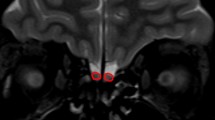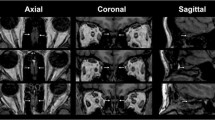Abstract
Purpose
In this study, we aimed to radiologically evaluate the olfactory bulb (OB) volume and olfactory sulcus (OS) depth of adult patients diagnosed with chronic autoimmune thyroiditis.
Methods
Sixty-eight patients over 18 years of age with Hashimoto’s thyroiditis and 66 healthy controls with normal thyroid function tests were included in the study. OB volume and OS depth measurements were performed using cranial magnetic resonance imaging (MRI) obtained from coronal T2-weighted images. The relationship between thyroid function tests, autoantibodies, and measurements of the OB and OS were evaluated.
Results
The right and left OB volumes were significantly lower in the patients with Hashimoto’s thyroiditis than in the control group (p < 0.05). No significant difference was found between the patient and control groups in terms of OS depth (p > 0.05). There were significantly negative correlations among TSH, thyroid antibodies, and the bilateral OB volume measurements. In the Bonferroni post hoc analysis, when people with euthyroid Hashimoto’s thyroiditis and the control group were compared, there was no statistically significant difference between bilateral OB volumes and thyroid function tests.
Conclusion
Diminished bilateral OB volumes were found in our patients with chronic autoimmune thyroiditis. Interestingly, the OB volumes were not affected in patients with euthyroid Hashimoto’s thyroiditis. When a decrease in OB volume is detected on MRI, it should be kept in mind that odor dysfunction in hypothyroid patients with Hashimoto’s thyroiditis may occur and patients should be clinically evaluated.





Similar content being viewed by others
References
Dayan CM, Daniels GH (1996) Chronic autoimmune thyroiditis. N Engl J Med 335(2):99–107. https://doi.org/10.1056/NEJM199607113350206 (PMID: 8649497 Review. Noabstractavailable)
Günbey E, Karlı R, Gökosmanoğlu F et al (2015) Evaluation of olfactory function in adults with primary hypothyroidism. Int Forum Allergy Rhinol 5(10):919–922. https://doi.org/10.1002/alr.21565 (Epub 2015 Jun 10)
Mincer DL, Jialal I (2021) Hashimoto thyroiditis. StatPearls [Internet]. StatPearls Publishing, Treasure Island (FL) (2022 Jan–PMID: 29083758)
Strous RD, Shoenfeld Y (2006) To smell the immune system: olfaction, autoimmunity and brain involvement. Autoimmun Rev 6(1):54–60 (Epub 2006 Aug 1. Review)
Schriever VA, Gellrich J, von der Hagen M, Hummel T (2018) Acquired olfactory dysfunction in children and adolescents: a systematic review of the literature. Chem Senses 43(8):571–581. https://doi.org/10.1093/chemse/bjy046
Perricone C, Shoenfeld N, Agmon-Levin N, de Carolis C, Perricone R, Shoenfeld Y (2013) Smell and autoimmunity: a comprehensive review. Clin Rev Allergy Immunol 45(1):87–96. https://doi.org/10.1007/s12016-012-8343-x.Review
Moscavitch SD, Szyper-Kravitz M, Shoenfeld Y (2009) Smell: integrating neurodegeneration and autoimmunity - a personal view. Acta Reumatol Port 34(2):190–196 (Review. Portuguese)
Katzav A, Ben-Ziv T, Blank M, Pick CG, Shoenfeld Y, Chapman J (2014) Antibody-specific behavioral effects: intracerebroventricular injection of antiphospholipid antibodies induces hyperactive behavior while anti-ribosomal-P antibodies induces depression and smell deficits in mice. J Neuroimmunol 272(1–2):10–15. https://doi.org/10.1016/j.jneuroim.2014.04.003 (Epub 2014 Apr 16)
Doğan A, Bayar Muluk N, Şahan MH, Asal N, Inal M, Ergün U (2018) Olfactory bulbus volume and olfactory sulcus depth in migraine patients: an MRI evaluation. Eur Arch Otorhinolaryngol 275(8):2005–2011. https://doi.org/10.1007/s00405-018-5029-x (Epub 2018 Jun 6)
Baskoy K, Ay SA, Altundag A et al (2016) Is there any effect on smell and taste functions with levothyroxine treatment in subclinical hypothyroidism? PLoS One 11(2):e0149979. https://doi.org/10.1371/journal.pone.0149979 (eCollection 2016)
Duprez TP, Rombaux P (2010) Imaging the olfactory tract. Eur J Radiol 74:288–298
Asal N, Bayar Muluk N, Inal M, Şahan MH, Doğan A, Buturak SV (2018) Olfactory bulbus volume and olfactory sulcus depth in psychotic patients and patients with anxiety disorder/depression. Eur Arch Otorhinolaryngol 275(12):3017–3024. https://doi.org/10.1007/s00405-018-5187-x (Epub 2018 Oct 31)
McConnell RJ, Menendez CE, Smith FR, Henkin RI, Rivlin RS (1975) Defects of taste and smell in patients with hypothyroidism. Am J Med 59(3):354–364
Deniz F, Ay SA, Salihoglu M et al (2016) Thyroid hormone replacement therapy improves olfaction and taste sensitivity in primary hypothyroid patients: a prospective randomised clinical trial. Exp Clin Endocrinol Diabetes 124(9):562–567 (Epub 2016 Jul 20)
Greer JM, Broadley S, Pender MP (2017) Reactivity to novel autoantigens in patients with coexisting central nervous system demyelinating disease and autoimmune thyroid disease. Front Immunol 8(8):514. https://doi.org/10.3389/fimmu.2017.00514 (eCollection 2017)
Dhong HJ, Kim HY, Ha BS (2003) Histologic changes to olfactory epithelium in hypothyroid rats. Otolaryngol Head Neck Surg 129(1):24–32. https://doi.org/10.1016/s0194-5998(03)00530-8 (PMID: 12869912)
Paternostro MA, Meisami E (1996) Essential role of thyroid hormones in maturation of olfactory receptor neurons: an immunocytochemical study of number and cytoarchitecture of OMP-positive cells in developing rats. Int J Dev Neurosci 14(7–8):867–880. https://doi.org/10.1016/s0736-5748(96)00064-0 (PMID: 9010731)
Zhang L, Blomgren K, Kuhn HG, Cooper-Kuhn CM (2009) Effects of postnatal thyroid hormone deficiency on neurogenesis in the juvenile and adult rat. Neurobiol Dis 34(2):366–374. https://doi.org/10.1016/j.nbd.2009.02.006 (Epub 2009 Feb 20 PMID: 19233274)
Funding
There are no financial disclosures of the authors. There are no funds for this article.
Author information
Authors and Affiliations
Contributions
Guarantor of integrity of the entire study: Mikail Inal. Study concepts and design: MI, ŞAD, AG. Literature research: MI, ŞAD. Clinical studies: ŞAD, AG. Experimental studies/data analysis: NA, MI. Statistical analysis: IK. Manuscript preparation: MI, ŞAD. Manuscript editing: MI, ŞAD.
Corresponding author
Ethics declarations
Conflict of interest
The author’s declare that they have no conlict of interest.
Ethical approval
This study is retrospective. Ethics committee approval was obtained from Kirikkale University Non-invasive Research Ethics Committee (date: 18/09/2019 issue: 2019/15).
Informed consent
There is no need to take informed consent, because the data were evaluated retrospectively.
Additional information
Publisher's Note
Springer Nature remains neutral with regard to jurisdictional claims in published maps and institutional affiliations.
Rights and permissions
About this article
Cite this article
Inal, M., Asal, N., Karahan, I. et al. Evaluation of peripheral olfactory pathways in chronic autoimmune thyroiditis. Eur Arch Otorhinolaryngol 279, 4525–4532 (2022). https://doi.org/10.1007/s00405-022-07373-z
Received:
Accepted:
Published:
Issue Date:
DOI: https://doi.org/10.1007/s00405-022-07373-z




